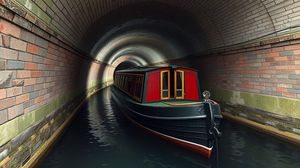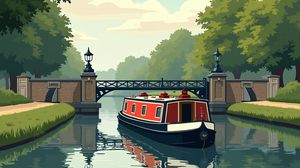
The Islington Tunnel is a fascinating engineering marvel situated beneath the vibrant area of Islington in London, forming a crucial part of the Regent's Canal. This hidden gem, extending about 878 meters, is the longest tunnel on the canal and passes under some of the borough's busiest streets.
Completed in 1820, the Islington Tunnel was constructed during the industrial revolution to ease congestion from growing transport demands. Its creation was a significant feat of its time, carving through the dense urban landscape without any vertical airshafts, a rarity for canal tunnels of its length.
Interestingly, the Islington Tunnel doesn't have a towpath. This meant that in its early days, boats had to be manually 'legged' through the tunnel—an arduous process where boatmen lay on their backs and pushed against the tunnel walls with their feet.
During World War II, the tunnel played a lesser-known role as a shelter from air raids. Though not officially designated as such, parts of the local canal network, including the tunnel, offered some protection during the Blitz.
Unlike many other canal tunnels, the Islington Tunnel isn't open to pedestrians, since it lacks alternative foot access. Instead, today's visitors can pass through on one of the popular canal boat tours, experiencing the tunnel's eerie yet intriguing atmosphere firsthand.
Despite its subterranean existence, the tunnel exerts influence on the surface too. It marks a historical boundary between different parts of Islington, in some ways connecting and dividing neighborhoods with its concealed trajectory.

Making the Most of Your Visit:
If you're planning to take a canal boat tour through the Islington Tunnel, make sure to bring a light jacket or sweater, even in the summer. The temperature can be quite a bit cooler inside the tunnel.
Once on the canal boat, try to get a spot near the front. The experience of entering the dark tunnel and then emerging on the other side with sunlight illuminating the canal is quite thrilling.
Before or after your tunnel adventure, take a stroll along the Regent's Canal's towpath outside the tunnel. You'll find it to be a peaceful escape with charming views of the city that many tourists miss.
For those who enjoy photography, make sure to capture the change in light as your boat moves through the tunnel. The contrast between the dark interior and the light at both ends makes for some dramatic shots.
Bring some snacks or have a picnic in the nearby Islington Green. It's a great way to relax and soak in the surroundings after your underground canal journey.

Visiting Times & Costs:
The Islington Canal Tunnel is part of the Regent's Canal, and while the tunnel itself is not accessible on foot, visitors can experience it via canal boat tours. These tours are offered by various canal boat companies and typically operate from spring to autumn. It's advisable to check with individual tour operators for specific schedules and availability.
The cost of canal boat tours through the Islington Tunnel varies depending on the operator, but generally, you can expect to pay for a ticket. Prices can vary so it's recommended to check with tour operators for the current pricing. There is no entrance fee for the tunnel itself since direct pedestrian access isn't allowed.
Accessibility may be limited depending on the canal boat operator. Some boats may have provisions for wheelchair access, but it's important to confirm with the specific tour operator regarding accessibility options.

Address & Map:

Nearby:























